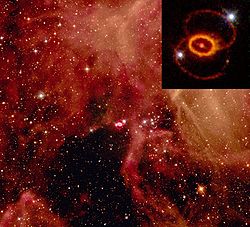Sanduleak -69° 202
| Observation data Epoch J2000 Equinox J2000 |
|
|---|---|
| Constellation | Dorado |
| Right ascension | 05h 35m 27.92s |
| Declination | −69° 16′ 11.1″ |
| Characteristics | |
| Spectral type | B3 Ia |
| Astrometry | |
| Distance | 168,000 ly (51,400pc) |
| Details | |
| Mass | ~20 M☉ |
| Luminosity | ~100,000 L☉ |
| Temperature | 16,000 K |
| Other designations | |
|
Sk -69° 202, GSC 09162-00821
|
|
| Database references | |
| SIMBAD | data |
Sanduleak -69° 202 (Sk -69° 202, also known as GSC 09162-00821) was a magnitude 12 blue supergiant star, located on the outskirts of the Tarantula Nebula in the Large Magellanic Cloud. It is notable as the progenitor of supernova 1987A.
The star was originally charted by the Romanian-American astronomer Nicholas Sanduleak in 1970, but remained just a number in a catalogue until identified as the star that exploded in the first naked eye supernova since the invention of the telescope.
The discovery that a blue supergiant was a supernova progenitor contradicted all known theories at the time and produced a flurry of new ideas about how such a thing might happen, but it is now accepted that blue supergiants are a normal progenitor for some supernovae.
The candidate luminous blue variable (LBV) HD 168625 possesses a bipolar nebula that is a close twin of that around Sk -69° 202. It is speculated that Sk -69° 202 may have been an LBV in the recent past, although it was apparently a normal luminous supergiant at the time it exploded.
...
Wikipedia

